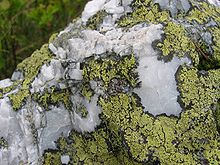Lichenometry


Inarchaeology,palaeontology,andgeomorphology,lichenometryis a geomorphic method ofgeochronologicdating that useslichengrowth to determine theage of exposed rock,based on a presumed specific rate of increase in radial size over time.[1][2]: 9 Measuring the diameter of the largest lichen of a species on a rock surface can therefore be used to determine the length of time the rock has been exposed. Lichen can be preserved on old rock faces for up to 10,000 years,[3]providing the maximum age limit of the technique, though it is most accurate (within 10% error) when applied to surfaces that have been exposed for less than 1,000 years.[4](The practical limit of the technique might be 4,000 to 5,000 years.[3]) Lichenometry is especially useful for dating surfaces less than 500 years old, as radiocarbon dating techniques are less accurate over this period.[5]The lichens most commonly used for lichenometry are those of the generaRhizocarpon(e.g. the speciesRhizocarpon geographicum) andXanthoria.The measured growth rates ofR. geographicumtends to fall within the range of 0.9–0.3 millimeter per year, depending on several factors, including the size of the lichen patch.[6]
The technique was first employed byKnut Fægriin 1933, though the first exclusively lichenometric paper was not published until 1950, by AustrianRoland Beschel,[7]in a paper concerning the EuropeanAlps.[8]
Scope and limitations
[edit]
Lichenometry can provide dates forglacialdeposits intundraenvironments, lake level changes, glacialmoraines,trim lines,palaeofloods,[9]rockfalls, seismic events associated with the rockfalls,[2]talus (scree) stabilization and former extent ofpermafrostor very persistent snow cover.[10]It has also been explored as a tool in assessing the speed ofglacier retreatdue toclimate change.[11]
Among the potential problems of the technique are the difficulty of correctly identifying the species, delay between exposure and colonization, varying growth rates from region to region as well as the fact that growth rates are not always constant over time, dependence of the rate of growth upon substrate texture and composition, climate, and determining which lichen is the largest.[5]
Methods
[edit]
Several methods exist for dating surfaces with help of lichenometry; the most simple relies on a single largest lichen while other methods use more. There are also differences in the way the lichen is measured; while some suggest that the largestdiametershould be measured, other scientists prefer the diameter of the largest inscribed circle. A problem in dating lichens is the fact that severalthallican fuse together, making several minor lichens appears as a larger one of older age.[12]Lichenometrist Tom Bradwell has listed the following five method families as the principal ones into which most other methods can be classified:
- Largest lichen (LL):When the single largest lichen of a species is used it means that the lichen that is oldest or grows in most favorable conditions is used to date the minimum age of the exposed surface. This was the original lichenometric from which others then developed or used as reference. Despite relying upon a single lichen this technique is praised for its simplicity and allows obtaining an image of the age of rock exposure while still in the field.[13]
- Largest five lichens (5LL):This method is a development of theLLand was developed in the 1970s to avoid reliance on one single potentially anomalous lichen. It has been proved that neither accuracy nor precision improves significantly by having more than five lichens.[13]
- Fixed-area largest lichen (FALL):This technique was initially specially designed for dating rockfalls andtalus coneswith no uniform age of deposition. The largestthallusin a unit area is measured. The sample areas are usually boulders with surfaces of about 1 m2.[13]
- Size-frequency approach (SF):The analysis of size and frequency of lichens was initially done in order to study lichen populations and preexisting thalli growing on surfaces, but has since been used as an effective absolute and relative dating method.[13]
- Lichen cover approach (LC):This method works with the premise of that the area covered by a single species will increase over time, and by measuring the total area percentage covered by a certain lichen species the age of exposure can be inferred.[13]
References
[edit]- ^Holocene climatic and glacial history of the central Sierra Nevada, California, R.R. Curry, pp. 1–47, 1969, Geological Society of America Special Paper, 123, S.A. Schumm and W.C. Bradley, eds., 1969
- ^abLichens in relation to management issues in the Sierra Nevada national parks, McCune, B., J. Grenon, and E. Martin, L. Mutch, Sierra Nevada Network, Cooperative agreement CA9088A0008. Oregon State University, Corvallis, Oregon, and Sequoia and Kings Canyon National Parks, Three Rivers, California,[1]
- ^abBenedict, James B. (January 2009). "A Review of Lichenometric Dating and Its Applications to Archaeology".American Antiquity.74(1): 143–172.doi:10.1017/S0002731600047545.S2CID83108496.
- ^Sowers, J.M., Noller, J.S., and Lettis, W.R., eds., 1997, Dating and Earthquakes: Review of Quaternary Geochronology and its Application to Paleoseismology. U.S. Nuclear Regulatory Commission, NUREG/CR 5562.
- ^abInnes, John L."Lichenometry".Progress in Physical Geography.9(187).
- ^Armstrong, R. A. (August 1983)."Growth Curve of the LichenRhizocarpon Geographicum".New Phytologist.94(4): 619–622.doi:10.1111/j.1469-8137.1983.tb04870.x.ISSN0028-646X.
- ^Beschel, R.(1950). "Flechten als Altersmasstab rezenter Moränen".Zeitschrift für Gletscherkunde und Glazialgeologie.1:152–161.
- ^"Lichenometry".Archived fromthe originalon 2008-08-23.Retrieved2009-02-25.
- ^William Allen (2013)https://www.scribd.com/doc/156523915/A-Lichenometric-Study-of-Palaeofloods-in-the-Brecon-Beacons
- ^Solomina, Olga; Ivanov, Mikhail; Bradwell, Tom (2010). "Lichenometric studies on moraines in the Polar Urals".Geografiska Annaler: Series A, Physical Geography.92(1): 81–99.JSTOR40661039.
- ^Richard Armstrong (September 2004)."Lichens, Lichenometry, and Global Warming"(PDF).Microbiologist:32–35. Archived fromthe original(PDF)on 2009-02-25.
- ^Lichen, Lichenometry and Global WarmingArchived2011-07-08 at theWayback Machine
- ^abcdeBradwell, Tom (2009). "Lichenometric Dating: A commentary in the light of some recent statistical studies".Geografiska Annaler.
Further reading
[edit]- Winchester, Vanessa (2023)."Lichenometric dating and its limitations and problems: a guide for practitioners".Land.12(3): 611.doi:10.3390/land12030611.
